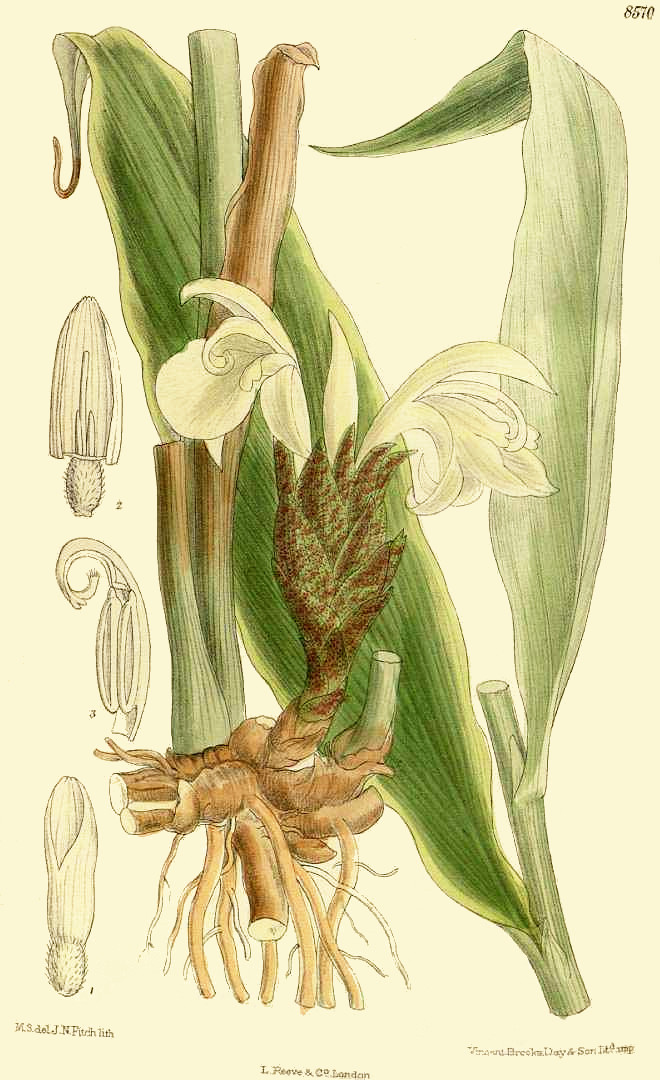Dies ist eine alte Version des Dokuments!
Zingiber mioga (Thunb.) Roscoe syn. Amomum mioga Thunberg - Zingiberaceae - ミョウガ myōga (japan.), Yangha (korean.), 蘘荷 rang he (chin.), Myoga, Japanese ginger, Japanischer Ingwer
Deciduous herbaceous perennial native to Japan, China, and the southern part of Korea.
„Traditional crop in Japan, myoga ginger has been introduced to cultivation in Australia and New Zealand… Only its edible flower buds and flavorful shoots are used in cooking. The flower buds are finely shredded and used in Japanese cuisine as a garnish for miso soup, sunomono, and dishes such as roasted eggplant. In Korean cuisine, the flower buds are skewered alternately with pieces of meat and then are pan-fried.“ Myoga (wikipedia)
The major volatile hydrocarbon compounds from myoga were β-phellandrene, β-elemene and β-pinene, while the major volatile oxygenated compounds were (Z)-3-hexenol, linalool, pinocarveol, pentadecanal and indole. By GC-sniffing, 2-isopropyl-3-methoxypyrazine, 2-sec-butyl-3-methoxypyrazine and 2-isobutyl-3-methoxypyrazine were identified and „…are considered to contribute to the green earthy part of the characteristic aroma properties of myoga, because they had low odor threshold values of 0.002 ppb, 0.001 ppb and 0.002 ppb, respectively, and to play an important role in myoga aroma, because they do not occur in other Zingiber species.“
[Kurobayashi, Yoshiko, et al. „Volatile Flavor Compounds of Myoga (Zingiber Mioga).“ Agricultural and biological chemistry 55.6 (1991): 1655-1657]
Main volatile flavor compounds of Yangha extracted by steam distillation and extraction method were β-pinene (16.5%), β-terpinene (14.9%), β-phellandrene (11.6%), sabinene (7.1%), α-pinene (6.8%), 1,4-terpineol (4.5%), and cryptone (4.0%).
[Lee, Jang-Won, et al. „Effects of Antioxidant and Flavor Compionents of Zingiber mioga Rosc.“ Korean Journal of Medicinal Crop Science 15.3 (2007): 203-209]
Miogadial, miogatrial (and also polygodial e.g. of Persicaria hydropiper and Persicaria odorata) primarily activate TRPA1 to induce pungency. These three compounds „…activated TRPA1 that was heterologously expressed in HEK293 or CHO cells. The potencies of activation by the 3 terpenoids were equal and almost 10 times stronger than that of allyl isothiocyanate (AITC), which is known as the most potent TRPA1 agonist among all natural products.“
[Iwasaki, Yusaku, et al. „Miogadial and miogatrial with α,β-unsaturated 1,4-dialdehyde moieties - Novel and potent TRPA1 agonists.“ Life sciences 85.1-2 (2009): 60-69]
Flower buds, rhizomes, stems, and leaves of myoga plants contained the pungent compounds miogadial (5-27 mg/100g of fresh sample) and miogatrial (7-40 mg/100g of fresh sample).
阿部雅子. "ミョウガの辛味関連化合物に関する研究." 日本調理科学会誌 52.1 (2019): 1-7

Curtis’s Botanical Magazine, vol 140 t.8570(1914) [M.Smith]
http://www.plantillustrations.org/illustration.php?id_illustration=7299

Japanese ginger buds prepared for sale (2015), author: Nesnad Wikimedia Commons
